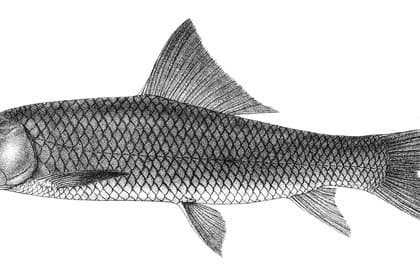Mrigal Carp: Biology, Distribution, and Ecological Impact
Mrigal carp (Cirrhinus mrigala) is a species of freshwater fish that is widely cultivated and consumed in South Asia. Despite its popularity as a food fish, the introduction of mrigal carp to new habitats has had negative impacts on local ecosystems and native species. In this article, we will examine the biology, distribution, and ecological impact of mrigal carp.

Mrigal carp (Cirrhinus mrigala) is a species of freshwater fish that belongs to the family Cyprinidae. This species is native to the rivers and lakes of South Asia, where it is an important food fish. Despite its popularity as a food fish, the introduction of mrigal carp to new habitats has had negative impacts on local ecosystems and native species.
Biology
Mrigal carp are medium-sized fish that can grow up to 60 cm in length and weigh up to 4 kg. They have a slender, cylindrical body shape and a small, downward-facing mouth that is adapted for feeding on small organisms in the water column.
The diet of mrigal carp consists primarily of phytoplankton, zooplankton, and benthic invertebrates, but they are also known to feed on algae, detritus, and other small aquatic organisms. They are opportunistic feeders and have been observed feeding on a wide range of food items, including insects and crustaceans.
Mrigal carp are capable of reproducing in large numbers, with females capable of producing up to 200,000 eggs per year. This, combined with their high rate of survival, has allowed the species to quickly establish populations in new habitats.
Distribution
Mrigal carp are native to the rivers and lakes of South Asia, including India, Bangladesh, and Pakistan. However, they have been introduced to several other countries, including some countries in Southeast Asia and Africa, for aquaculture purposes.
In their native range, mrigal carp are one of the most important food fish, and are widely cultivated in ponds and other aquatic habitats. In many countries, they are also an important target for recreational fishing.
Ecological Impact
The introduction of mrigal carp to new habitats has had negative impacts on local ecosystems and native species. The species is capable of outcompeting native fish for food and habitat, and their feeding behavior can result in a reduction of the amount of phytoplankton available for other aquatic species.
The introduction of mrigal carp has also resulted in the decline of several native fish species, including some species of cyprinids, which are important components of the local food web. The decline of these native species can have cascading effects on the local ecosystem, including changes in food web dynamics and altered nutrient cycling.
Conclusion
Mrigal carp is a freshwater fish species that is native to the rivers and lakes of South Asia and is an important food fish in the region. Despite its popularity as a food fish, the introduction of mrigal carp to new habitats has had negative impacts on local ecosystems and native species, including the decline of native fish species and competition for food and habitat. In order to mitigate the negative impacts of mrigal carp, it is important to implement effective management and control measures.
No comments yet, be the first to share your thoughts!
Newsletter
Sign up for our newsletter and stay up-to-date on the latest tips, tricks, and techniques in carp fishing. From beginner to expert, our newsletter offers something for every level of angler. Do not miss out on exclusive content, product reviews and fishing reports that will help you catch more carp.
Related Posts
Carp Fishing Fleece: The Ultimate Guide for Anglers
almost 3 years ago
Carp Species and Natural Habitat
almost 3 years ago
Fish Have Excellent Memories: A Fun Fact for Anglers
almost 3 years ago
Where to find and how to catch Prussian Carp in Fishing Planet
almost 3 years ago
The Ultimate Guide to Choosing the Best Landing Net for Carp Fishing
almost 3 years ago
20 Premier Carp Fishing Locations in Yorkshire and the Humber
over 1 year ago